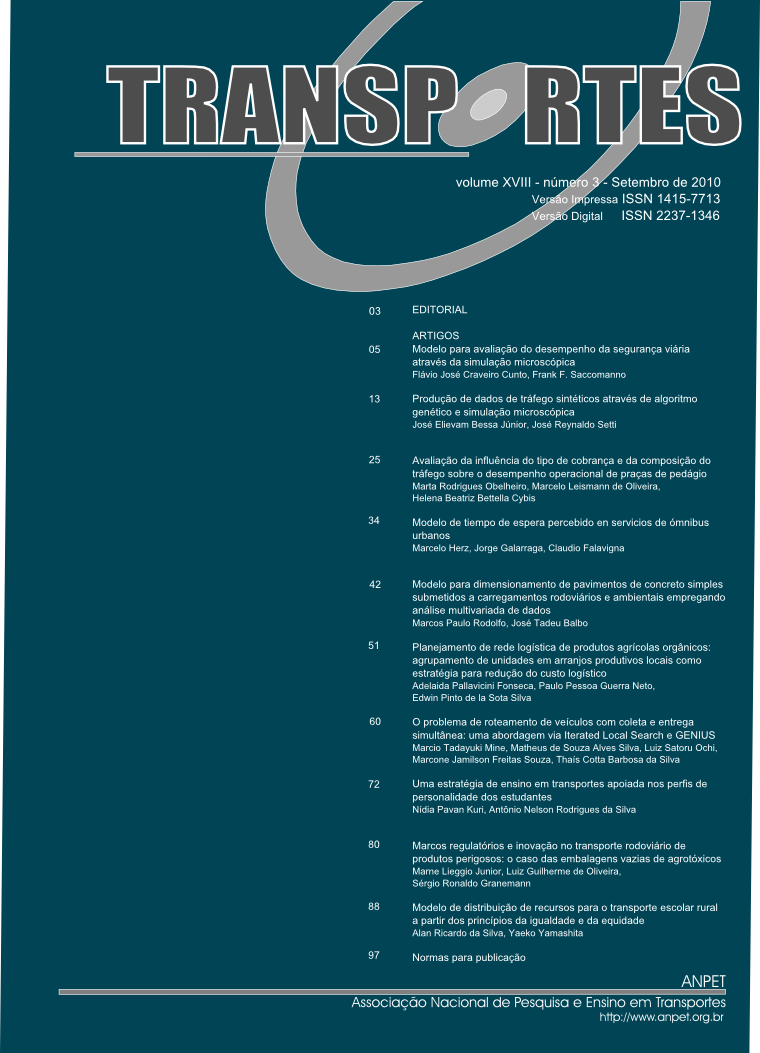Marcos regulatórios e inovação no transporte rodoviário de produtos perigosos: o caso das embalagens vazias de agrotóxicos
DOI:
https://doi.org/10.14295/transportes.v18i3.454Abstract
Resumo: O objetivo deste trabalho é analisar a inovação provocada pelos marcos regulatórios na logística do transporte rodoviário de produtos perigosos, especificamente na logística das embalagens de agrotóxicos. O quadro teórico de referência aborda a Teoria da Inovação, a questão de marcos regulatórios, riscos no transporte rodoviário de produtos perigosos e o necessário uso de rotinas. A metodologia utilizada na confecção do trabalho teve caráter exploratório, baseando-se em revisão bibliográfica e nas práticas operacionais de mercado. Os resultados da pesquisa mostraram que, ao adaptar-se às novas exigências legais do ambiente institucional em que se insere, a cadeia logística reversa de embalagens de agrotóxicos produziu inovações em seu processo, utilizando-se de “recursos produtos não-utilizados”, rotinas e lições aprendidas em sua trajetória tecnológica.
Abstract: The objective of this study is to analyze the innovation caused by the regulatory framework in the logistics of transport of dangerous goods, specifically in the logistics of packing of pesticides. The theoretical frame of reference addresses: a Theory of Innovation, the question of regulatory framework, risks in road transport of dangerous goods and necessary use of routines. The methodology used in making the work was exploratory character, based on literature review and the operational practices of the market. The survey results showed that by adapting to new legal requirements of the institutional environment which includes the reverse supply chain of packaging for pesticides produced innovations in their process, applying unused productive resources (waste), routines and lessons learned in its history technology.Downloads
Downloads
Published
How to Cite
Issue
Section
License
Authors who submit papers for publication by TRANSPORTES agree to the following terms:
- The authors retain the copyright and grant Transportes the right of first publication of the manuscript, without any financial charge, and waive any other remuneration for its publication by ANPET.
- Upon publication by Transportes, the manuscript is automatically licensed under the Creative Commons License CC BY 4.0 license. This license permits the work to be shared with proper attribution to the authors and its original publication in this journal, and to be adapted for non-commercial purposes, provided appropriate credit is given and any derivative works are distributed under the same terms.
- Authors are authorized to enter into additional separate contracts for the non-exclusive distribution of the version of the manuscript published in this journal (e.g., publishing in an institutional repository or as a book chapter), with recognition of the initial publication in this journal, provided that such a contract does not imply an endorsement of the content of the manuscript or the new medium by ANPET.
- Authors are permitted and encouraged to publish and distribute their work online (e.g., in institutional repositories or on their personal websites) after the editorial process is complete. As Transportes provides open access to all published issues, authors are encouraged to use links to the DOI of their article in these cases.
- Authors guarantee that they have obtained the necessary authorization from their employers for the transfer of rights under this agreement, if these employers hold any copyright over the manuscript. Additionally, authors assume all responsibility for any copyright infringements by these employers, releasing ANPET and Transportes from any responsibility in this regard.
- Authors assume full responsibility for the content of the manuscript, including the necessary and appropriate authorizations for the disclosure of collected data and obtained results, releasing ANPET and Transportes from any responsibility in this regard.









